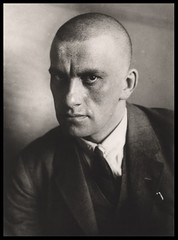Wednesday, 18 April 2012
Alexander Rodchenko
Russian born graphic designer, artist, sculptor and photographer. His aesthetic is extremely bold, arranging big blocks of colour and slabs of black into dramatic shapes. He is well known for his poster work such as his “Knigi” window poster from 1925 (p18, Elliot, 1979), though his work was allot more varied than just poster designs. As one of the founders of constructivism, his work spans many mediums. From painting and sculpting abstract geometric shapes to photo-montage with incorporated typography. Though I don't personally like his sculpture, it was clearly influenced by his contemporaries like Naum Gabo and Tatlin, and they frankly do it better. His painting in the same vain as his sculpture however, is interesting. His drawing encapsulates so much energy in it's lines that I can't help but be drawn in (his tempera paintings from 1917 and the oil on wood compositions from 1920 for example).
What I'm a real fan of is his photomontage work from 1923 to 1927. The way the images and type fit together in these almost (if not actual) propaganda style posters create such bold imagery. Even with my limited ability to read russian (ie no ability), I find myself jumping from word to word trying to read them phonetically. The “Battleship Potemkin” poster (1925) uses symmetry and blocks of text to reflect the czarist themes or mechanical order within the film.
Elliot, David: Alexander Rodchenco (1979); published by MoMA Oxford.
Labels:
Discourse
Subscribe to:
Post Comments (Atom)

No comments:
Post a Comment